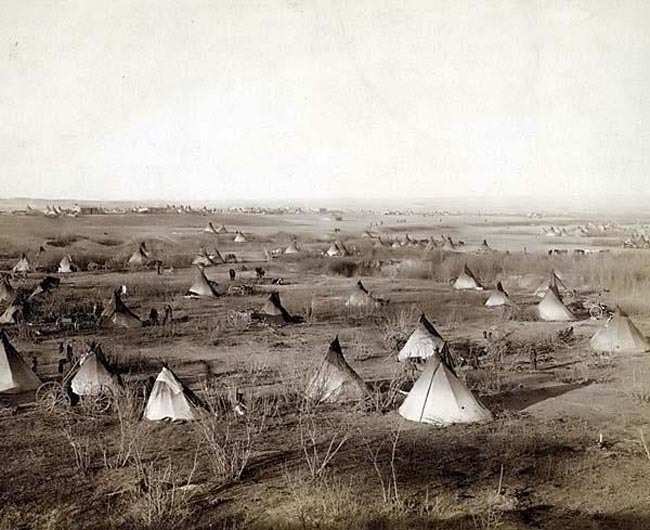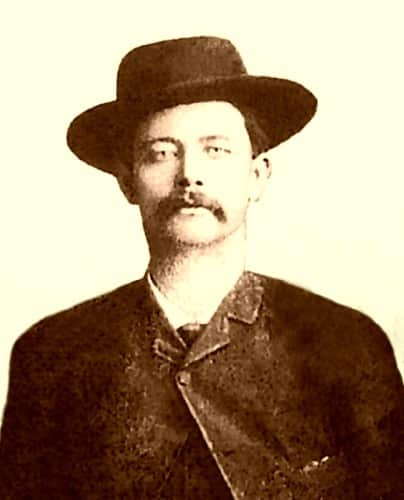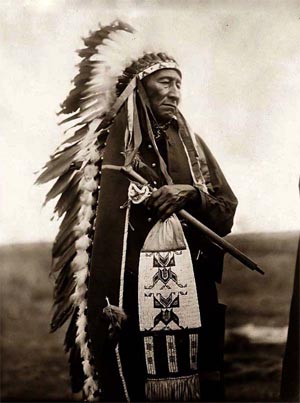 People are drawn to the rugged beauty of the Badlands. These geologic deposits contain one of the world's richest fossil beds. Ancient mammals such as the rhino, horse, and saber-toothed cat once roamed here. The park's 244,000 acres protect an expanse of mixed-grass prairie where bison, bighorn sheep, deer, pronghorn, prairie dogs, and black-footed ferrets live today. People are drawn to the rugged beauty of the Badlands. These geologic deposits contain one of the world's richest fossil beds. Ancient mammals such as the rhino, horse, and saber-toothed cat once roamed here. The park's 244,000 acres protect an expanse of mixed-grass prairie where bison, bighorn sheep, deer, pronghorn, prairie dogs, and black-footed ferrets live today.
| ||||||||||
Contrary to popular conception, there was little glamour in the Old West, and the wonderful adventure it offered in the books and films that chronicled its past was largely mythical. It was a place of unspeakable hardships and dangers.
 Early death threatened the pioneers at all turns, from hostile Indians to vicious weather, disease, and roaming white renegades who slaughtered the innocent indiscriminately to obtain and hold the West's most precious commodity - land. It was the land that caused the range wars, where cattle barons attempted to wipe out the small ranchers, the immigrant farmers, or the sheepherders whose flocks vied with cattle for the grazing lands.
Early death threatened the pioneers at all turns, from hostile Indians to vicious weather, disease, and roaming white renegades who slaughtered the innocent indiscriminately to obtain and hold the West's most precious commodity - land. It was the land that caused the range wars, where cattle barons attempted to wipe out the small ranchers, the immigrant farmers, or the sheepherders whose flocks vied with cattle for the grazing lands.It was the land that became precious once the railroads sliced through its far horizons in search of the cattle to be shipped east to beef-hungry millions. Along the steel paths of the railroads mushroomed the cattle towns of the West - Ellsworth, Hays, Wichita and Dodge City in Kansas, and with these early-day settlements came the cowboy, adept with horse and gun, the tools he would later employ in robbing banks and trains and killing for hire.
Ellsworth, Hays, Wichita and Dodge City in Kansas, and with these early-day settlements came the cowboy, adept with horse and gun, the tools he would later employ in robbing banks and trains and killing for hire.
 Ellsworth, Hays, Wichita and Dodge City in Kansas, and with these early-day settlements came the cowboy, adept with horse and gun, the tools he would later employ in robbing banks and trains and killing for hire.
Ellsworth, Hays, Wichita and Dodge City in Kansas, and with these early-day settlements came the cowboy, adept with horse and gun, the tools he would later employ in robbing banks and trains and killing for hire.
The towns themselves, from Leadville to Deadwood, from Silver City to Tombstone, were little more at the beginning than a huddle of clapboard shacks and rutted mud streets. Hygiene was practically nonexistent, and settlers died prematurely of diseases long since vanquished by modern medicine. Saloons and bordellos were usually in greater number than churches and schools in these towns, if any of the latter existed at all. The women of the town were mostly prostitutes who casually spread veneral diseases of all sorts.

Those women married to businessmen of the merchant class kept to small rooms in dark hotels and rooming houses in town; those wedded to small ranchers and farmers dwelled in rough-built farmhouses squatting in the desolate landscape, cooking and cleaning their lives away. The women who became celebrated in the West were invariably prostitutes who prospered and became gamblers, or ribald characters such as Calamity Jane. The so-called "bandit queens," Belle Starr and Cattle Kate Watson, were really inconsequential persons within the ranks of the outlaws and were thought of as such by their male counterparts.

Belle Starr, despite the Hollywood treatment she later received, was nothing more than a petty horse thief, an ugly harridan who used her gunfighter husbands to shoot down individuals she disliked. Cattle Kate Watson merely stocked the cattle stolen by her lover Jim Averill, for which she was later hanged. Calamity Jane (Martha Jane Canary), the most historically overblown female of the Old West, was never anything more than a common prostitute and a drunk. Her supposedly torrid love affair with gunman James Butler "Wild Bill" Hickok was the stuff of dime novel fiction. Calamity's claim following Hickok's death-that she was married to the famed gunfighter - was merely her wild hope of clinging to the odd fame of the Old West, but one she insisted upon with such fervor that she was eventually buried next to Hickok, who hardly knew her in real life.

It was a man's world indeed, one in which a man generally prospered if he carried and used a gun well, or could afford to hire gunmen to protect his interests. The gunmen who hired out to the cattle barons or the merchant princes did not magically spring from the windswept western earth. They were homegrown, as it were, from the cattle ranches, these gunfighters and bandits beginning as cowboys or farm hands who visited the lawless railheads when driving herds of cattle from the south and southwest.

These unschooled youths, most of them illiterate, had become experts with the six-gun and the rifle while battling Indians, rustlers, and the wild animals of the plains. They rode horses with ease and thought nothing of traveling hundreds of miles in the saddle. The cowboy knew little of civilization, except when visiting its rough precincts in the cattle towns, thus he had no use for its laws or those charged with enforcing them. He easily became a bandit or a gunfighter without having to make a moral decision based upon an appreciation of ethics and morality he had never acquired. He became a "bad man" only in the eyes of those who understood his actions as crimes. Murder and robbery to the unschooled outlaw were survival actions, ways of life.
Like his twentieth-century counterpart, the western bad man was boldest when working with gangs. It was the old western gangs, many held together with blood ties, that launched the first daring raids against banks and railroads.  Most of these outlaw bands were made up of brothers such as the Burrow gang, the Renos, the James-Younger band, and the Daltons. When the gangs were exterminated, splintered, or disbanded, the individual bandit became a furtive desperado who took unrealistic chances and increased his risk of capture. Rather than face the possibility of jail - an abhorrent thought to any western criminal - many an outlaw, when cornered with no hope of escape, committed suicide. Such was the case of Harvey Logan (Kid Curry), Harry Tracy, Grant Wheeler, and possibly the notorious Sundance Kid and Butch Cassidy.
Most of these outlaw bands were made up of brothers such as the Burrow gang, the Renos, the James-Younger band, and the Daltons. When the gangs were exterminated, splintered, or disbanded, the individual bandit became a furtive desperado who took unrealistic chances and increased his risk of capture. Rather than face the possibility of jail - an abhorrent thought to any western criminal - many an outlaw, when cornered with no hope of escape, committed suicide. Such was the case of Harvey Logan (Kid Curry), Harry Tracy, Grant Wheeler, and possibly the notorious Sundance Kid and Butch Cassidy.
 Most of these outlaw bands were made up of brothers such as the Burrow gang, the Renos, the James-Younger band, and the Daltons. When the gangs were exterminated, splintered, or disbanded, the individual bandit became a furtive desperado who took unrealistic chances and increased his risk of capture. Rather than face the possibility of jail - an abhorrent thought to any western criminal - many an outlaw, when cornered with no hope of escape, committed suicide. Such was the case of Harvey Logan (Kid Curry), Harry Tracy, Grant Wheeler, and possibly the notorious Sundance Kid and Butch Cassidy.
Most of these outlaw bands were made up of brothers such as the Burrow gang, the Renos, the James-Younger band, and the Daltons. When the gangs were exterminated, splintered, or disbanded, the individual bandit became a furtive desperado who took unrealistic chances and increased his risk of capture. Rather than face the possibility of jail - an abhorrent thought to any western criminal - many an outlaw, when cornered with no hope of escape, committed suicide. Such was the case of Harvey Logan (Kid Curry), Harry Tracy, Grant Wheeler, and possibly the notorious Sundance Kid and Butch Cassidy.
Suicide as a self-inflicted act was less prominent among western gunfighters, who made their living as killers-for-hire, enforcing the edicts of the land-greedy cattle barons. They killed mostly from ambush and seldom, unless drunk in a saloon, fought it out with opponents in head-to-head combat. Most of these gunmen, who had learned their special knowledge of weapons and marksmanship as youthful cowboys, were little more than hired assassins, such as Jim "Killer" Miller. In general, the Old West was never noble or altruistic, although it had a smattering of principled men of the law to lend that illusion to latter day historians. There were few high noon duels in which gunman and lawman faced one another bravcly and fought to the death, the rare exception being the gunfight between the Earp and the Clanton-McLowery factions in Tombstone in 1887. For the most part the western gunman was a sneaky, backshooting killer who fired from ambush, lurking in the shadows of dark alleys or behind walls, rocks, and trees while waiting to send an anonymous bullet into his victim.

There existed, however, a special breed of gunfighter who thrived on gunfighting alone, having no ambition other than to best an opponent with a faster draw and a deadlier aim. These men were rare in the West, egotistical to the point of lunacy, and certainly many could have been certified as insane. These gunmen included the mercurial Billy the Kid, the unpredictable Clay Allison, the hot-tempered Ben Thompson, and the vainglorious John Wesley Hardin, who proudly claimed to have killed forty men in gun duels before he himself was shot in the back while rolling dice in a saloon.
The western lawmen who faced these maniacs were also special individuals, as courageous as the outlaws were devious. They too had learned gunmanship at an early age, most being the sons of pioneers. It is interesting to note that in the backgrounds of most of the famous lawmen, such as Wyatt Earp, a strong family unit was present with parents who preached early to their sons the moral necessity of obeying and upholding the law. Even more interesting is the fact that these men, for the most part, had both mother and father throughout their childhoods, whereas a good deal of the outlaws, bandits and gunmen that plagued the Old West grew up with only one parent, invariably a stern father with little time to spend with sons, the mother having died early. Many of the worst outlaws were orphaned as youths and had no parental guidance at all.

The father of Frank and Jesse James deserted his family to join the California Gold Rush, which led to his early death; he left his two sons to be raised by a mother who dominated their lives and was fiercely loyal to them, excusing their crimes to come and defending them against all who criticized their outlaw ways. It was the same case with the Daltons and their mother. (This same attitude was ruthlessly displayed in the twentieth century by Ma Barker, mother of the notorious Barker Brothers.)
Outlaw sons seemed also to have an almost pathological devotion to their mothers. When Pinkerton detectives accidentally blew off the arm of Jesse James's mother, the outlaw traveled to Chicago and lay in wait to kill the firm's founder, Alan Pinkerton. Before their last bank robbery - the disastrous 1892 raid in Coffeyville, Kansas-Bob, Grat, and Emmett Dalton rode to their homestead and, fearing to go nearer lest waiting lawmen capture them, watched their mother during the night inside the lighted Dalton farmhouse in silent farewell to the person who meant most in their nefarious lives.
The Wild West was not a term of hindsight. It was called that during its own time and for good reason. Life and humanity meant little to its anxious inhabitants, and during the heyday of the lawless bandits and gunmen, between 1850 and 1900, only a few resolute men with tin stars stood up to the lawbreaker, risking and losing their lives at an alarming rate to win the West for unborn generations. The willing courage of these few good men is the true legacy of the Old West, to be found now only in the myriad boot hills that marked their way.
For every individual who relied upon his weapon for protection, there were many others who saw it as a means to an end. The day of the pistoleer had arrived. In the early days of the American West gunfighters were called 'shootists' or 'mankillers'. The word gunfighter was first used by Cemetery Sam in Eureka, California, in 1874. However, the word gunfighter was not generally used until the 20th century.
In an interview that he gave late in life, Wyatt Earp claimed that deliberation rather than speed was the most important key to survival in a gunfight. The experienced gunman, said Earp, "took his time and pulled the trigger once." Bat Masterson also gave advice to men wanting to be gunfighters: "Many a man has been buried because he foolishly tried to scare someone by reaching for his hardware ... Always have your gun loaded and ready, and never reach for it unless you are in dead earnest and intend to kill."The average year of birth was 1853. The average year of death was 1895. About 1/3 of all gunmen died of "natural causes." Many gunmen did not die violently and lived a normal life span (70 years or so). Of those who did die violently (shot or executed), the average age of death was 35. The gunfighters-turned-lawmen lived longer lives than their persistently criminal counterparts.
Most professional gunfighters died in states or territories where the most shootings occurred: Texas, Kansas, New Mexico, Oklahoma, California, Missouri, and Colorado.
The "occupations" of the various gunmen were often those that used firearms in ordinary pursuits. They often carried firearms as a job requirement. There were 110 gunmen who were law officers, 75 who were cowboys, 54 as ranchers, 46 as farmers, 45 as rustlers, 35 as hired guns, but also men who had been soldiers, miners, scouts, teamsters, actors, butchers, bounty hunters, etc.
Gunfighting peaked in the 1870s: Six fights in TX and KS in 1870, 22 in 1871, 13 in 1872, 27 in 1873, 14 in 1874, 13 in 1875, 22 in 1876, 21 in 1877, 36 in 1878, 14 in 1879. In the 1880s: 25 in 1880, 27 in 1881, 15 in 1882, 9 in 1883, 17 in 1884, 7 each in 1885-6, 20 in 1887, 10 in 1888, and nine in 1889. 1895-96 were bad years, 19 fights in each, but then it began to taper off.
Sam Bass: (21 July 1851 - 21 July 1878) Born near Mitchell, Indiana. After numerous 'money-making' ventures Sam had formed a partnership with Joel Collins and Jack Davis. After driving a herd of cattle to Dodge City, then on to Ogallaha in the South Platte Valley, they decided to venture on to the Black Hills. They tried unsuccessfully to establish a freighting outfit. Sam had pointed out that "It's pretty hard to quit our old trade and go into a business that don't pay any better than this." With this Sam and Collins began to form their gang; Tom Nixon, Bill Heffridge and Jim Berry. Their first target was the Deadwood Stage, they held it up four times, from Jul To Aug 1877. With only seven peaches and less than $50 as their total loot, they agreed to try one more time when Collins had learned of a shipment of $150,000 in gold dust.  The holdup was a failure, which drove them the Union Pacific would be more profitable. The gang's first train robbery was their most successful. At Big Springs, Nebraska, the loot was $60,000 dollars in shiny new twenty dollar gold coins from the San Francisco mint. The passengers of the train turned over an additional $400 cash and gold watches. | |





No comments:
Post a Comment